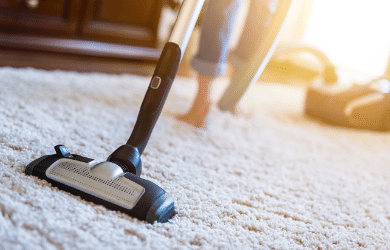6 Cleaning Tips to Make Your Home Healthier in the New Year
December 30, 2014

1. Regularly wipe down countertops. Countertops are not only where food is prepared, but it’s also where dirt, dust, germs, and allergen particles floating in the air often settle. If you have a countertop with granite or tile, it’s best to use a mild cleaner and preferably one that can refresh the sealer.
Sealers can degrade over time and it’s important to keep that sealer fresh to prevent germs from getting into the porous areas of the stone.
2. Keep carpets and rugs clean. To improve the life and appearance of your carpet, vacuum your carpets and rugs weekly with a bag vacuum, preferably one that has either a HEPA filter or a microfiltration system. However, it is important to note that while vacuuming does pick up dirt and dust on the surface, there can still be non-living allergens trapped deep down within the fibers of the carpet – including pet dander and urine, particle pollution, and everyday dirt and dust.
While not be visible to homeowners, non-living allergens can still be the source of unpleasant health issues and allergy symptoms. Vacuuming and routine cleaning are helpful in maintaining cleaner carpets, but they are simply not enough. For this reason, the EPA recommends getting carpets professionally cleaned at least once a year. If you have pets and/or children at home, it's recommended you use a professional cleaning service, such as Chem-Dry, two to three times per year.
For homeowners with pets, it’s advisable to find a professional cleaning service that has an effective urine detection and removal process. To protect your carpets from future stains, request adding a protectant, which puts a protective coating on the carpet fibers and makes it easier to keep carpets cleaner for a longer period of time on your own.
3. Don’t forget about your upholstered furniture. Most people think about vacuuming and cleaning their carpets and rugs but they forget about cleaning their upholstery, despite spending significant time every day on their couches and chairs.
Similar to countertops and carpets, particles like dust, dirt, and allergens settle on upholstered furniture as well. Vacuuming upholstered furniture is nearly as easy and is just as important as carpets, particularly in high-traffic areas like family rooms. It’s recommended to vacuum the upholstery in your home once every other week and have it professionally cleaned once a year.
4. Clean high touchpoints around the house. Popular “hot spots” include doorknobs, toilet handles, faucets, and light switches. Spending a few minutes cleaning those areas, particularly before and after guests come into the home, can go a long way toward minimizing the spread of germs.
More preventive approaches to minimizing the spread of germs include being vigilant about washing your hands regularly throughout the day and placing a bottle of hand cleaning solution in the high-traffic areas of the home, making it easy and convenient to keep your hands clean and germ-free.
5. Use doormats or area rugs in entryways and high-traffic areas. While it’s easy to forget them, doormats and area rugs do a great job of trapping dirt and allergens before they enter the heart of your home. Part of the reason they aren’t as common in homes today is due to the misconception that hard surfaces are healthier than carpets or rugs, which is not the case.
The fact is that carpets and rugs act as filters that capture and trap dirt, dust, and allergens and prevent them from getting into the air and spreading throughout the home. On hard surfaces, these particles simply settle and then are stirred back into the air the next time there is traffic and activity in the area.
Using doormats and area rugs is an effective and inexpensive way to prevent unwanted and unhealthy particles from getting deeper into your home or from remaining in the air where they can spread more easily to members of the family.
6. Check and replace your heating and air conditioning filters. While furnaces are vital to keeping homes warm in the colder months, it’s important to change the furnace air filter at regular intervals to prevent dirt, dust, and other unhealthy particles from being distributed around the house. Follow the recommended replacement timing for each filter that is indicated on the filter package.
To remind yourself when it’s time to change the filter, write the date that you’re performing the replacement on the outer edge of the new filter that you’re installing to make it easy to know when your next one is due. Another way to stay on schedule with future filter replacements is to send yourself an invitation in your online calendar for the date of the next replacement or for replacements for the remainder of the year, based on the manufacturer’s recommended cycle.
*Based on results from a study conducted by an independent laboratory using the Chem-Dry Hot Carbonating Extraction process. Allergens tested were dog and cat dander and dust mite matter. Figures are an average across multiple homes.